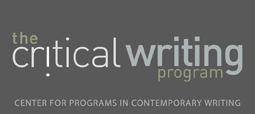Information Strategy and Economics
Overview of the Discipline
Scholars in the field of Information Strategy and Economics contend with changes in information endowments and their impact on strategy.
Scholars address issues such as: technology's effect on the economics of businesses and governments, and the effect of the internet on consumer behavior and firm strategy.
To learn more about information strategy and economics,please visit: Wharton Information Strategy and Economics
WRITING IN THE DISCIPLINE
GOALS
The goals of writing in Information Strategy and Economics are problem definition and solution. Thus, scholars may write about a new model they may have that will help explain a phenomenon, a data set that with important implications, and general observations.
REASONING
When writing in Information Strategy Economics, the subject matter is very factual, with little room for opinion. Similar to Economics, writers must persuade the reader that their assumptions are reasonable. Just as writers with any original idea or explanations of a phenomenon, writers in this field must justify why their position is correct.
EVIDENCE
Evidence typically used in Information Strategy Economics includes theoretical modeling, large sample emperical work such as surveys and data sets, and case analysis (examining case studies to determine what happened and what therefore may be infered).
Although most research in this field is quantatative/data-based, there is an emeging group of scholars engaged in text-based research.
AUTHORSHIP
Writing in this field is generally a collaborative process done within small groups of no more than 3 authors. Only 20-30% of work has a single author.
CLAIMS
Writing Tips
When writing articles in this field, scholars engage in a three step process: researching, drafting, and submitting. First, writers research data and write a review of pertinant literature. Next, they circulate their work between co-authors and others who are influential in the field, and present their works at discussion-based conferences. Lastly, they revise in light of the feedback.
In papers in this field, writers should include (1) an Introduction, (2) a Literature Review, (3) Problem Definition and Solution Approach (where they justify their assumptions), (4) Analysis and Results (where they present their data), (5) and their Discussion and Conclusions.
When producing non-scholarly work, there is no difference in the writing process aside from the length of time it takes to be published. Even non-scholarly articles are subject to less formal review by professionals within the field.
Rankings
When writing in this field, the most important aspects teachers look for are original ideas, mastery of others' ideas, following instructions, reasoning and evidence, and organization. The less important criterea include: grammar and mechanics, style, formatting, and citations.
The best way for students to learn what is expected is to imitate the structure, style and content of the better written academic pieces.
Common Errors
Common errors found in students' writing include: logically inconsistent analysis, students who cannot differentiate between creative and analytical writing, high variance/inconcistency in grammar, not structuring the paper, and not answering the question asked.
Style
Requires Further Research
Genres
Types of writing within this field include: scholarly articles, technical reports, cases, and opinion pieces.
Typical Student Assignments
Typical student assignments in this field include short essays and business plans.
In short essays, writers are typically asked to answer a very targeted question(s) in less than 2 pages. When writing, students should use terse and concise economic arguments and answer using economic principles. The goal of these assignmensts is for the writer to demonstrate an understanding of the economic rules and their applications to a particular case.
Sample short essay question: "Explain whether or not this pricing mechanism is a good idea and whether or not you can do better."
Business plans are more open-ended and writing them is probably the most ambitious task that students are asked to complete.For example: This list is derived from "Sample Table of Contents" (p. 32) from Business Plans that Win $$$ (Rich and Gumpert, 1987), and on the assignments Professor Hitt historically used in OPIM 210. Color coding: Black is used for things that might be relevant for some projects but are not critical for this assignment. Red is used for things that almost certainly should be addressed. Items that have been crossed out will not actually be necessary for the course and will not be possible to address for most course projects.
Examples of Scholarly Writing
"Why Advertising is Failing on the Internet" by Eric Clemons"Business Models for Monetizing Internet Applications and Web Sites: Experience, Theory and Predictions." by Perunjodi Naidoo, Prabha Ramseook-Munhurrun, Eric Clemons
© 2013 The University of Pennsylvania


